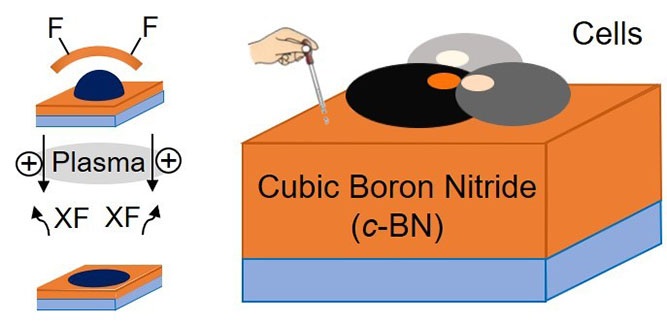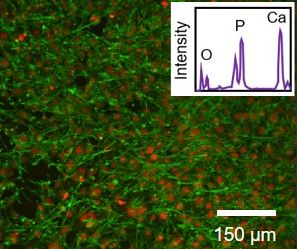研究成果 Research Results
- TOP
- News
- Research Results
- Biocompatible and second only to diamond in hardness
Biocompatible and second only to diamond in hardness
Cubic boron nitride shown to be promising as an ultrahard coating for bio-applications 2020.11.04Research ResultsMaterials
An international team of researchers has reported for the first time the biocompatibility of the second hardest known material, opening the possibility for a new ultrahard coating material for biological and biomedical applications.

Schematics of plasma modification of a c-BN film for enhancing wettability and biological test on a c-BN film.
Second only to diamond in hardness, cubic boron nitride (c-BN) has a crystalline structure similar to that of the precious stone but with boron and nitrogen atoms instead of carbon. But any slight disadvantage c-BN may have in terms of hardness it makes up for with superior stability, not reacting to oxygen and ferrous materials even at high temperatures up to around 1,000 °C, unlike diamond.
However, synthesis of high-quality c-BN has been difficult until recently, so applications for c-BN are more than twenty years behind diamond. Furthermore, most attention has been put on mechanical and electronic applications such as for cutting tools and semiconductors.
New research from Kyushu University, the National Institute for Materials Science, and Stony Brook University (USA) now shows that c-BN is also promising for harsh biological environments in contact with living organisms and blood.

Image of cells cultured on a c-BN film and typical energy dispersive X-ray spectroscopy spectrum.
Preparing high-quality c-BN films with a plasma chemical vapor deposition technique that they developed, the research team found they could enhance the film’s surface wettability—basically how well water, and cells, can adhere to it—using a plasma treatment technique that includes bombarding the surface with low-energy ions.
The team demonstrated successfully the growth of a large number of cells and the formation of mineral deposits—indicative of biomineralisation—on the superhydrophilic c-BN films prepared in this way.
These results confirm the high potential of c-BN as a noncytotoxic, ultrahard coating material for biological and biomedical applications such as artificial bones, dental implants, and biosensors.
###
For more information about this research, see “Biocompatible cubic boron nitride: A noncytotoxic ultrahard material,” Jason H. C. Yang, Kungen Teii, Chung-Chueh Chang, Seiichiro Matsumoto, and Miriam Rafailovich, Advanced Functional Materials (2020). https://doi.org/10.1002/adfm.202005066
This work was supported in part by a Grant-in-Aid for Scientific Research (B) from the Japan Society for the Promotion of Science and “Funding Program for Next Generation World-Leading Researchers” from Cabinet Office, Government of Japan (PI: Kungen Teii).
Research-related inquiries
Kungen Tsutsui (Teii), Associate Professor
Department of Advanced Energy Science and Engineering, Faculty of Engineering Sciences
Contact information can also be found in the full release.
- TOP
- News
- Research Results
- Biocompatible and second only to diamond in hardness































